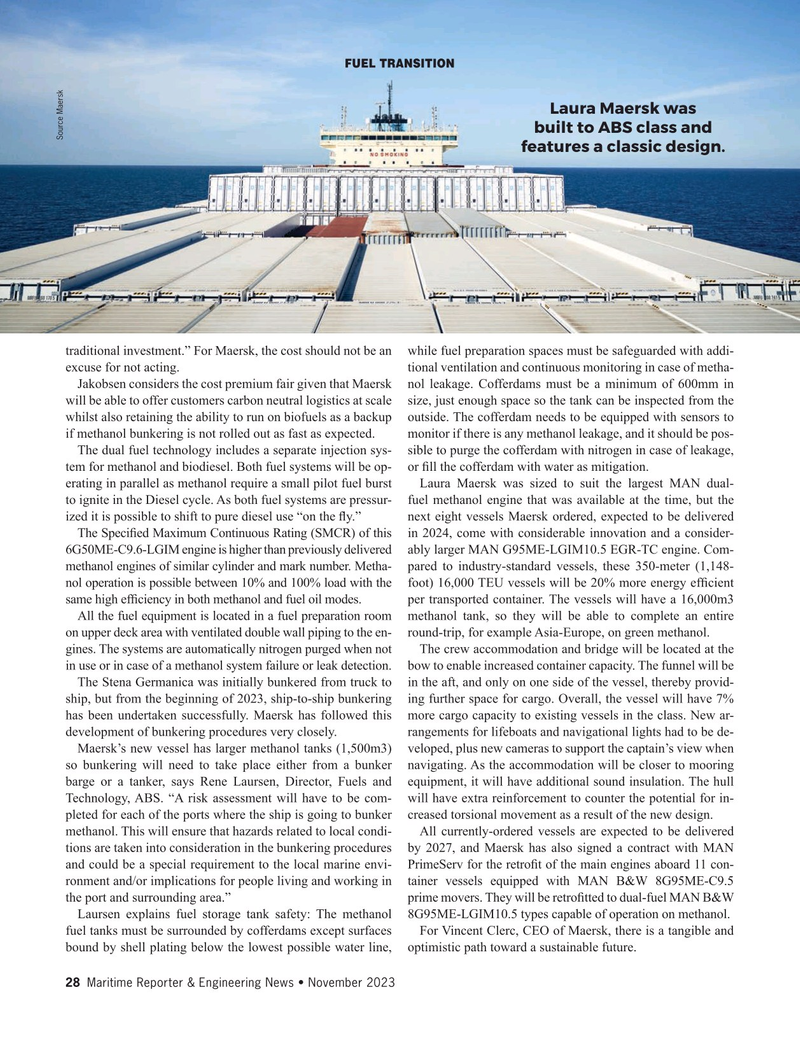
Page 28: of Maritime Reporter Magazine (November 2023)
Workboat Edition
Read this page in Pdf, Flash or Html5 edition of November 2023 Maritime Reporter Magazine
FUEL TRANSITION
Laura Maersk was built to ABS class and
Source Maersk features a classic design. traditional investment.” For Maersk, the cost should not be an while fuel preparation spaces must be safeguarded with addi- excuse for not acting. tional ventilation and continuous monitoring in case of metha-
Jakobsen considers the cost premium fair given that Maersk nol leakage. Cofferdams must be a minimum of 600mm in will be able to offer customers carbon neutral logistics at scale size, just enough space so the tank can be inspected from the whilst also retaining the ability to run on biofuels as a backup outside. The cofferdam needs to be equipped with sensors to if methanol bunkering is not rolled out as fast as expected. monitor if there is any methanol leakage, and it should be pos-
The dual fuel technology includes a separate injection sys- sible to purge the cofferdam with nitrogen in case of leakage, tem for methanol and biodiesel. Both fuel systems will be op- or ? ll the cofferdam with water as mitigation. erating in parallel as methanol require a small pilot fuel burst Laura Maersk was sized to suit the largest MAN dual- to ignite in the Diesel cycle. As both fuel systems are pressur- fuel methanol engine that was available at the time, but the ized it is possible to shift to pure diesel use “on the ? y.” next eight vessels Maersk ordered, expected to be delivered
The Speci? ed Maximum Continuous Rating (SMCR) of this in 2024, come with considerable innovation and a consider- 6G50ME-C9.6-LGIM engine is higher than previously delivered ably larger MAN G95ME-LGIM10.5 EGR-TC engine. Com- methanol engines of similar cylinder and mark number. Metha- pared to industry-standard vessels, these 350-meter (1,148- nol operation is possible between 10% and 100% load with the foot) 16,000 TEU vessels will be 20% more energy ef? cient same high ef? ciency in both methanol and fuel oil modes. per transported container. The vessels will have a 16,000m3
All the fuel equipment is located in a fuel preparation room methanol tank, so they will be able to complete an entire on upper deck area with ventilated double wall piping to the en- round-trip, for example Asia-Europe, on green methanol.
gines. The systems are automatically nitrogen purged when not The crew accommodation and bridge will be located at the in use or in case of a methanol system failure or leak detection. bow to enable increased container capacity. The funnel will be
The Stena Germanica was initially bunkered from truck to in the aft, and only on one side of the vessel, thereby provid- ship, but from the beginning of 2023, ship-to-ship bunkering ing further space for cargo. Overall, the vessel will have 7% has been undertaken successfully. Maersk has followed this more cargo capacity to existing vessels in the class. New ar- development of bunkering procedures very closely. rangements for lifeboats and navigational lights had to be de-
Maersk’s new vessel has larger methanol tanks (1,500m3) veloped, plus new cameras to support the captain’s view when so bunkering will need to take place either from a bunker navigating. As the accommodation will be closer to mooring barge or a tanker, says Rene Laursen, Director, Fuels and equipment, it will have additional sound insulation. The hull
Technology, ABS. “A risk assessment will have to be com- will have extra reinforcement to counter the potential for in- pleted for each of the ports where the ship is going to bunker creased torsional movement as a result of the new design.
methanol. This will ensure that hazards related to local condi- All currently-ordered vessels are expected to be delivered tions are taken into consideration in the bunkering procedures by 2027, and Maersk has also signed a contract with MAN and could be a special requirement to the local marine envi- PrimeServ for the retro? t of the main engines aboard 11 con- ronment and/or implications for people living and working in tainer vessels equipped with MAN B&W 8G95ME-C9.5 the port and surrounding area.” prime movers. They will be retro? tted to dual-fuel MAN B&W
Laursen explains fuel storage tank safety: The methanol 8G95ME-LGIM10.5 types capable of operation on methanol. fuel tanks must be surrounded by cofferdams except surfaces For Vincent Clerc, CEO of Maersk, there is a tangible and bound by shell plating below the lowest possible water line, optimistic path toward a sustainable future.
28 Maritime Reporter & Engineering News • November 2023
MR #11 (18-33).indd 28 11/2/2023 9:17:12 AM

 27
27

 29
29
